基于足底压力和足部运动持续监测的日常行为运动负荷评价研究
Daily activity exercise load evaluation based on plantar pressure and foot motion monitoring
(本项目受微软亚洲研究院资助)
(This project was funded by Microsoft Research Asia)
适量的运动负荷对维持人体健康状态具有非常重要的作用,而过度的运动负荷不仅会使人疲劳,还会引发不同程度的损伤。因此对日常运动负荷的实时监测有着重要的意义。本项目的目标就是研制可对日常行为运动负荷和运动功能健康状态(是否疲劳)进行定量评价和预警的低成本、低干扰、低能耗的鞋垫式监测系统。
It is well known that appropriate exercise load plays a significant role in maintaining human health, but excessive exercise load may be harmful. This project aims to develop a low cost,�low power, low interference in-shoe monitoring system for real time evaluating of daily activity exercise load and early warning of foot fatigue. The main research contents include sensor layout determining, motion type distinguishing, energy consumption calculating, foot fatigue characteristics monitoring, and hardware design and realization.
1 日常行为中足底受力与特征点压强关系
1 The relationship between reaction force and plantar pressures in a few special positions
为了基于有限个特征点足底压力数据进行日常行为运动负荷的评价和预警,需要建立地面反力与特征点足底压力之间的关系,从而为传感器的有效布置提供依据
In order to evaluate exercise load based on plantar pressure in a few special positions during daily activities, it is necessary to know the relationship between reaction force and plantar pressures, so that an effective sensor layout for real-time plantar pressure measurement can be developed.
本项目中,通过Pedar-X足底压力测试系统采集受试者完成7种典型日常运动(站立,坐,原地跳跃,行走,慢跑,上楼和下楼)时的足底压力数据。随后,使用逐步线性回归对Pedar-X 99个传感器的压强数据进行分析,根据偏F检验的显著性,由高到低逐个引入关键位置的压强值,直到再引入一个后,各位置的压强值间出现严重多重共线性,以此分别得到7个在7种运动中基于少量测试点数据实时计算总足底压力的模型。然后,以Pedar-X系统测量得到的其他受试者完成7种单项运动和由7种运动组合的连续运动时的足底压力数据为实测值,对回归模型进行验证和比较。
In this project, Pedar-X pressure insoles were applied to collect the plantar pressures of healthy young adults during performing 7 typical motions (standing, sitting, vertical jump-landing, level walking, level running, stair ascending and stair descending). Stepwise linear regression was performed to reconstruct a mathematic model of calculating the foot force for each style of motion according to the 99 individual pressure data. Then these models were validated by comparing the plantar pressures measured by Pedar-X system and the estimated values by these models when other subjects conducted the same 7 motions and the task composed of those 7 motions.
结果表明,利用五个分别置于拇指、第二趾骨、第三趾骨、足跟内侧、足跟外侧的压力传感器(如图1)和行走运动的足底压力回归模型就可对日常运动下的总足底压力进行有效检测。图1显示了传感器的布置方案。
As a result, the foot force in daily life activities can be monitored effectively by level walking model with only 5 pressure sensors under T1, M2, M3, HM and HL regions. The sensor layout is illustrated in Fig 1.
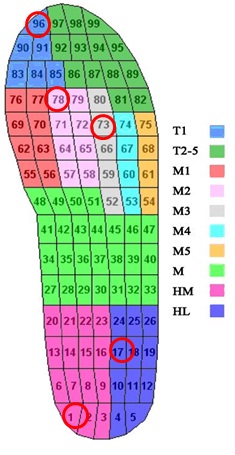
图1 能有效监测日常运动足底压力的传感器布置方案
Figure 1 Sensor layout for real-time plantar pressure measurement in daily life activities
2不同运动状态的识别
2 Motion type distinguishing
不同运动的负荷差异较大,为了进行运动负荷的监测和预警,首先需要对不同运动状态进行识别。图2显示了本项目中基于足底压力曲线进行运动状态识别的流程。验证实验表明, 项目中涉及的多数运动的识别率在85%以上
The exercise load of different motion is quite different, therefore, motion type distinguishing is important to evaluate exercise load and warn foot fatigue. Figure 2 shows the flow chart of motion distinguishes method in this project. The validation experiments show that the distinguishing rate is above 85% for most motion

图2 日常运动状态识别的流程图
Figure 2 Flow chart of motion type distinguishing in the daily life activities
3日常运动负荷的估算
3 Estimation of exercise load in daily life activities
能量消耗是评估运动负荷的客观依据。本项目中,用心肺功能仪测量典型日常运动的能量消耗,再把能耗对时间和体重归一化,得到每种运动单位体重的能耗率,根据运动量和能耗率,可得到相应运动的能量消耗。将监测到得能耗与建议的能耗标准进行比较,当能耗超出标准时提示控制运动强度,当不足时,提示进行适度运动。
Energy consumption is objective basis of estimating the exercise load. In this project, Cardio-pulmonary function tester was used to measure the energy consumption in each typical motion, and then energy consumption rate was computed. Based on the method of distinguish the motion type mentioned above, the duration of the each motion was also obtained, and the energy consumption in daily life activities could be estimated. The warning message will be given after comparing the estimated energy consumption and suggested energy consumption. Figure 3 shows the Process of estimating exercise load in this project
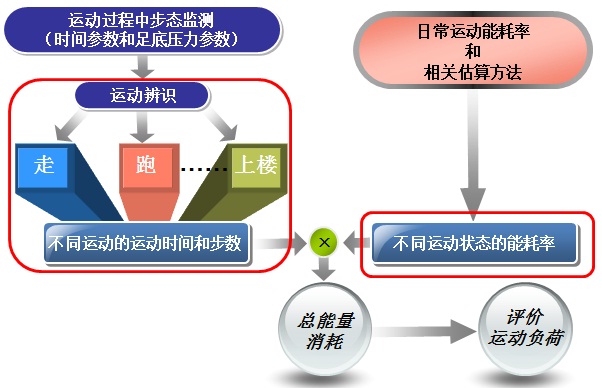
图3 日常运动负荷估算和评价的实现过程
Figure 3 Process of estimating exercise load in daily life activities
4足部疲劳特征监测
4 Foot fatigue characteristics monitoring
本项目中,分析了受试者完成长跑、往返跑和变速跑运动前后的足底压力变化情况,发现三种运动疲劳后,足底跖骨处的峰值压力和冲量会增大,而拇趾处的峰值压力和冲量会减小。基于这些特征,提出了图4所示的足部疲劳特征监测方法。
In this project, the planter pressure distributions before and after various motions were captured and analyzed. It shows that the peak force and impulse on metatarsus increased, but those in hallux decreased when foot fatigue happened. Based on these characteristics, a method of the foot fatigue evaluation and early warning is suggested, as shown in Fig 4.
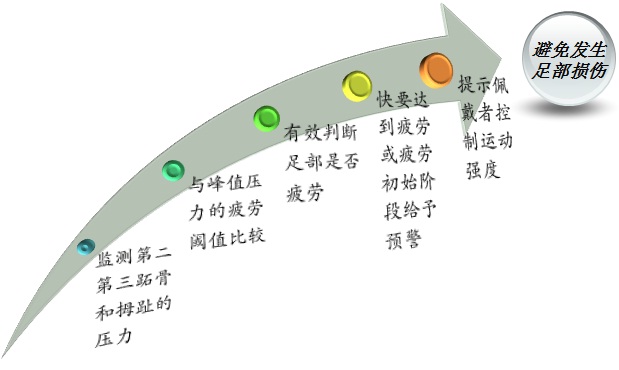
图4足部疲劳状态评价及预警实现过程
Figure 4 Process of the foot fatigue evaluation and early warning
5硬件设计与实现
5 Hardware design and realization
根据以上方案实现的鞋垫式足底压力监测系统应具有低成本、低干扰、低能耗的特点,能实现以下功能:实时监测采集运动参数,识别不同运动方式,运动负荷和人体运动功能健康状态的定量评价及预警。系统框图见图5. 系统对足底5个点的压力实时监测,信号经蓝牙发送至上位机(个人电脑、智能手机),通过专用软件完成实时显示、分析及保存等功能,如图6所示。系统的实验测试如图7所示。
采集系统具有以下特点:(1)简单小巧,采用超薄贴片压力传感器,硬件电路埋于鞋跟,不影响日常运动。(2)低功耗,单次充电可至少连续使用8小时。(3)低成本,单脚仅使用5路压力传感器。(4)高精度,A/D转换精度达到12位。
The in-sole pressure measure system based on the previous research should be low cost, low power, portable and user-friendly. It could monitor and collect foot force, distinguish motion type, evaluate exercise load, and early warn the fatigue.
The system structure is showed in Figure5 The pressure signal of 5 spots can be monitored, and sent in real time via Bluetooth to the upper machine (PC or smart phone). The signal can be real-time displayed, analyzed and saved by special designed applications, as shown in Fig 6.
The System has the following advantages: 1). Simple and small. Thanks to the ultra-thin force sensors and small size of hardware circuit, the subject’s daily exercise is smooth and non-interferential. 2).Low power. The endurance time is at least 8 hours for each charge. 3).Low cost. Only 5 force sensors are selected to locate on the insole according to the previous result. 4). High precision. The signals are converted by 12-bit on chip A/D.

图5 系统框图
Figure 5 The system structure
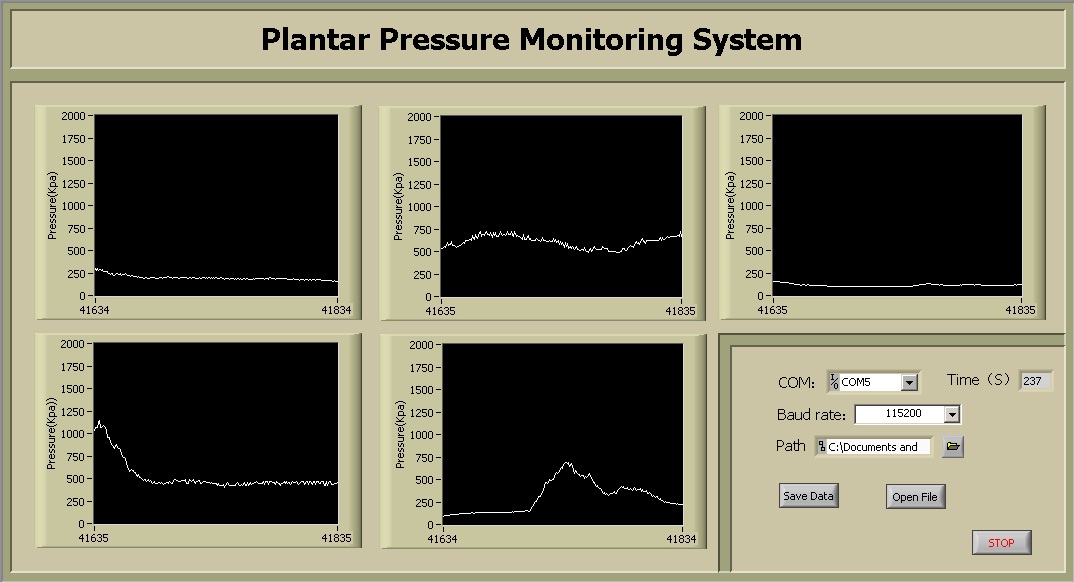
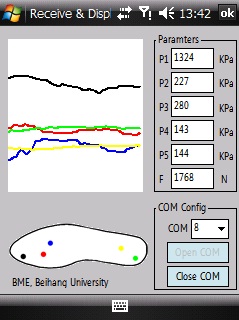
A B
图6 上位机程序界面
(A为计算机, B 为智能手机,WM6.0 Professional)
Figure 6 Program interface of upper computer
(A for computer, B for Smart Phone,WM6.0 Professional)
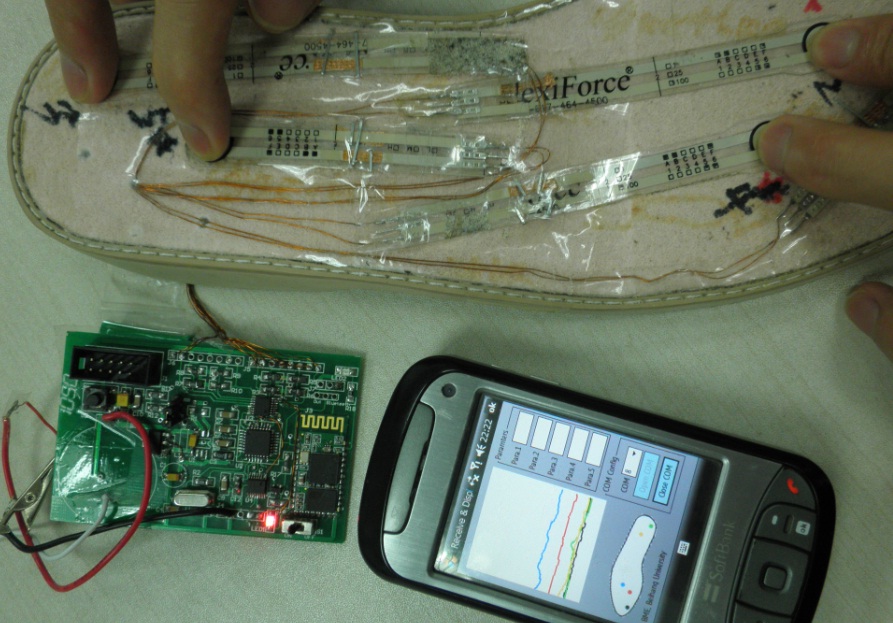
图7实验测试
Figure7 Testing of the system
6 相关论文
6 Papers
[1] Yang Yang, Pu Fang, Ren Lvping, Qian Yajun, Li Deyu, Fan Yubo, Hu Huimin, Yang Fan. Optimization of Sensor Layout for the Wearable System of Monitoring Foot Loads in Daily Life Activities. 2011 2nd Asia-Pacific Conference on Wearable Computing Systems (APWCS 2011), Changsha, China: 213-216.
[2] Qian Yajun, Li Deyu, Ren Lvping, Yang Yang, Pu Fang, Fan Yubo, Hu Huimin, Yang Fan. Estimation of Plantar Force in Different Motions for the Design of Wearable System of Monitoring Daily Life Activities. 2011 2nd Asia-Pacific Conference on Wearable Computing Systems (APWCS 2011), Changsha, China: 224-227.
[3] 杨阳, 蒲放, 钱雅君, 任稆平 李淑宇 李德玉, 樊瑜波. 面向日常运动负荷监测的足底压力实时检测方法. 医用生物力学(录用).
[4] Ren Lvping, Liu Chengrui, Yang Yang, Qian Yajun, Yang Songyan, Li Deyu, Pu Fang, Niu Haijun. Design of in-shoe plantar pressure monitoring system for daily activity exercise stress assessment. Accepted by BMEI’ 2011.